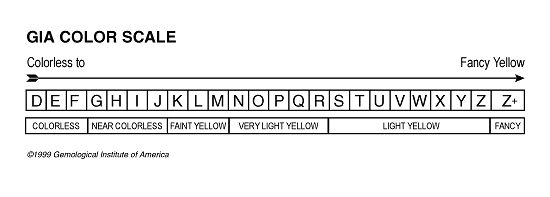Clarity
Few diamonds are pure diamonds through and through. Most Form with unique external and internal characteristics that can be likened to identifying birth or beauty marks. Gemologists call these distinguishing marks "blemishes" when they are found on the surface of stones and "inclusions" when they are found inside. Some blemishes such as pits or nicks occur naturally while others such as polishing marks are introduced by man at the time a stone is cut and polished. Just as diamonds are graded for color, so they are also graded for clarity – again using a system developed by GIA and modified slightly by leading labs in Europe and Asia.
Diamond Clarity Grades
The GIA clarity-grading system consists of 5 categories fl (flawless), vvs(very, very slightly included), vs (very slightly included), si (slightly included), and i (included) – which are subdivided into 11 grades, two for each category except i which has three.
Clarity Grades
For the most part, fine jewelers stock diamonds with si or better grades since the blemishes and inclusions in such stones are usually invisible to the naked eye. On the other hand, stones graded i usually have inclusions which are visible to the naked eye. That's why buying diamonds with vs and si clarity grades allows you to save money without compromising to any great extent on the appearance. At the same time, buying vs and si clarity diamonds allows budget-minded shoppers to hold the line on more dramatically visible quality factors such as color and cut.
Clarity Enhancement
In recent years, diamond technologist have found ways to either remove or camouflage visible inclusions using a variety of clarity-enhancement processes. Two worth noting here: laser-drilling and glass-filling.
Laser Drilling
Using lasers, technologists drill to black spots near the surface of stones, then inject acid which completely dissolves them. The process leaves only microscopic hairbreadth drill holes which usually require a jeweler's eyepiece (called a loupe) to see.
Glass Filling
Using glass fillers which are permanent under normal wearing conditions (high heat used for jewelry repairs will damage them) technologists hide white inclusions called "feathers" but while both treatments are commonly practiced nowadays, they are somewhat controversial and must, by FTC decree, be disclosed.

